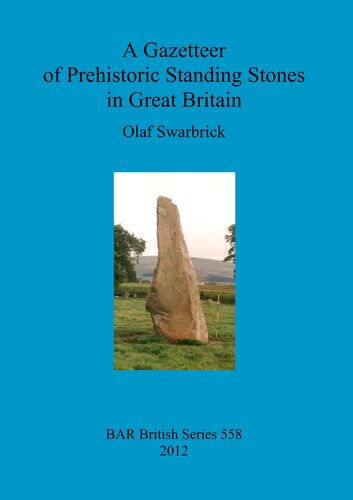

Most ebook files are in PDF format, so you can easily read them using various software such as Foxit Reader or directly on the Google Chrome browser.
Some ebook files are released by publishers in other formats such as .awz, .mobi, .epub, .fb2, etc. You may need to install specific software to read these formats on mobile/PC, such as Calibre.
Please read the tutorial at this link: https://ebookbell.com/faq
We offer FREE conversion to the popular formats you request; however, this may take some time. Therefore, right after payment, please email us, and we will try to provide the service as quickly as possible.
For some exceptional file formats or broken links (if any), please refrain from opening any disputes. Instead, email us first, and we will try to assist within a maximum of 6 hours.
EbookBell Team

4.8
104 reviewsA Gazetteer representing practical field observations of most of the prehistoric Standing Stones in Great Britain and some 'Other Stones' which post-date AD 1. The list also includes 34 prehistoric Standing Stones known to be extant but which the author was unable to visit, a list of Standing Stones of unknown provenance, and of interesting 'Other Stones'. The motivation for this work was the Wimblestone (Somerset, ST434585) which is an extant prehistoric Standing Stone close to the author' childhood home and which started his interest in these monuments. In September 1996 the author set out to find, visit and sketch the prehistoric Standing Stones in Great Britain and soon discovered that there was no readily available, and comprehensive list or lists of Standing Stones and their exact locations. Therefore, with numerous Standing Stones unknown to the author and others which were very difficult to find, the author decided to attempt to produce a readily usable gazetteer of as many as possible of the prehistoric Standing Stones in Great Britain (with the National Grid reference number for each) together with colour sketches, photographs, field records and relevant information gathered from various sources; deliberately excluded were stone circles, long stone rows, burial chambers and dolmens. Some Standing Stones were not visited because they were inaccessible for various reasons and these are separately listed. These and the other Standing Stones and some other stone monuments which postdate AD 1 are recorded in the gazetteers but are excluded from the analysis. Apparently unrecorded Standing Stones continue to be found, making the production of a totally comprehensive gazetteer of all the prehistoric Standing Stones in Great Britain the work of many lifetimes.